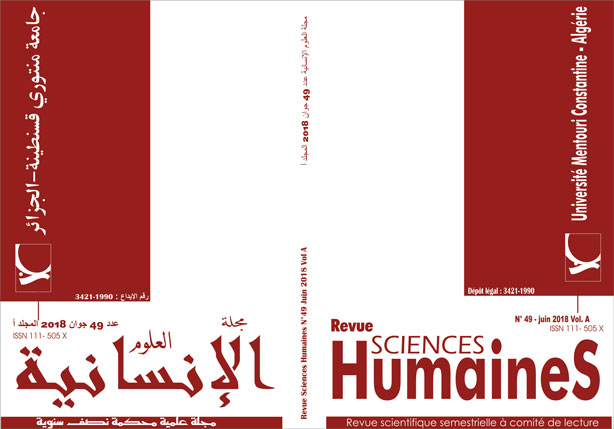Language and Identity on Facebook: an Online Ethnographic Study of Nicknames, Self-presentation and Religious Identity among a Sub-religious Group in Algeria.
Keywords:
Facebook, Nicknames, Identity, Salafis, Self-presentation, Social networking sitesAbstract
Early research on nicknames and self-presentation online focused on naming and identity in chatting rooms, gaming platforms and emails. However, recent studies have shifted their interest to naming and identity constructions in more user-generated networks known as Social Networking Sites. Great research has been conducted in the subject in the western world due to its novelty and deep social meaning especially on Facebook. Nicknames have been proved accordingly to be an essential identity marker in SNSs. Although having this great importance, the subject has not received a great attention in the Arab world. In Algeria, most studies focused on code-switching and language contact on Facebook and Twitter in the light of the diglossic situation of the country. The present study investigates naming and identity constructions on Facebook among a sub-religious group in Algeria known as Salafis. Applying the discourse-centered ethnographic research methods, 150 Male Facebook accounts in a friends’ network were analyzed and interviews with 30 participants were conducted. The study argues that the use of nicknames was dominant among Algerian Salafis to promote the religious affiliation identity rather than social one on Facebook. Two categories of nicknames emerged: ‘implicit nicknames with place of origin reference’ and ‘explicit with religious affiliation reference’. The characteristics of such identities are described and the implications of these findings are discussed.
Downloads
References
Alford, R.D. (1987). Naming and Identity: a Cross-cultural Study of Personal Naming Practices. New Haven, Connecticut: HRAF Press.
Androutsopoulos, Jannis. (2006). “Introduction: Sociolinguistics and Computer-mediated Communication”. Journal of Sociolinguistics. 10(4). 419–438
Barany, Lazgin et al. “Kurdish Personal Names in Kurdistan of Iraq: A Sociolinguistic Perspective”. academia.edu. Retrieved Oct, 2016.
Baron, Naomi S. (2008): Always on: Language in an Online and Mobile World. New York: Oxford University Press.
Bechar-Israeli H. (1995). “From to : nicknames, play and identity on Internet Relay Chat”. Journal of Computer-Mediated Communication, 1(2). Online. Available HTTP: <http://jcmc.indiana.edu/vol1/issue2/bechar.html> (accessed November 2015).
Boyd, Danah. (2001). "Depth Cues in Virtual Reality and Real World: Understanding Differences in Depth Perception by Studying Shape-from-shading and Motion Parallax.". Undergraduate computer science honours thesis. Brown University.
Boyd, M. Danah and Nicole B. Ellison. (2007). “Social Network Sites: Definition, History, and Scholarship”. Journal of computer mediated communication, 13(1). Pages 210–230
Cassidy, J. (2006). “Me media”. The New Yorker, (May 15), 50-59. Accessed Sept 2016
Cherny, Lynn.(1999). Conversation and Community: Chat in a Virtual World. Stanford: CSLI Publications
Fakuad, Gbenga et al. (2013). “The Sociolinguistics of Compound Surnames among some Educated Yoruba Married Women”. Language and Society.org. 3(2). Retrieved 16 Oct 2016.
Ganaoui, Manel. (2012). Al-logha Al-arabia Adet Tawassol ala Mawaqia al-twassol al-ijtimai: Dirassa Maydaniya Li Istiemal Al-arabia min Taref Al-djazairin ala Al-facebook [Arabic as a Communication Tool on Social Networking Sites: a Field Study of Arabic Use among Algerians on Facebook]. Al-moltaqa Al-watani hawla Al-mohtawa Al-raqmi bi Al-arabia: Al-nacher Al-iliktroni [National Symposium on Digital Content in Arabic: Electronic Publishing]. 24-12-2012. Al-majlis Al-aala Li logha Al-arabia fi Al-djazair [Higher Council of Arabic in Algeria]
Garcia, Cora Angela. et al. (2009). “Ethnographic Approaches to the Internet and Computer-Mediated Communication”. Journal of Contemporary Ethnography. 38(1): 52-84. Sage Publications.
Georgalou, Mariza. (2015). Constructions of Identity on Facebook: a Discourse-centred Online Ethnographic Study of Greek Users. Pusblished PhD Dissertation. Lancaster University.
Goffman, E.1990. (1959). The Presentation of Self in Everyday Life. London: Penguin.
Hagstrom, Charlotte. (2012).Naming Me, Naming You: Personal Names, Online Signatures and Cultural Meaning. In Botolv Helleland, Christian-Emil Ore & Solveig Wikstrøm (eds.). Names and Identities. Oslo Studies in Language. 4 (2): 81-93.
Heisler, J.M. & S.L. Crabill. (2006). “Who are ’Stinkybug’ and ’Packerfan4’? Email Pseudonyms and Participants’ Perceptions of Demography, Productivity, and Personality”. Journal of Computer-Mediated Communication, Vol.12, no.1
Helleland, Botolv, et al. (eds). (2012).“Names and Identities”. Oslo Studies in Language 4 (2).
Herring, Susan.(2013). Discourse in Web 2.0: Familiar, Reconfigured, and Emergent. In Deborah Tannen and Anna Marie Trester. (eds.). Discourse 2.0: Language and New Media. George Town University Press.
Hine, Christine . (2003).Virtual Ethnography. UK: University of Surrey.
Hutchinson, Andrew . Jan, 2017. “Top Social Network Demographics 2017.” socialmedia.com. Retrieved from http://www.socialmediatoday.com/social-networks/top-social-network-demographics-2017-infographic. March, 2017
Khidher, Mohammed Al-arabi. (2014). Al-tanawà Al-loghawi fi Shabaket Al-Facebook Al-tawassoliya wa Atharoho fi Mostwayat Al-logha Al-arabia [The Lingustic Diversity in the Social Networking Site Facebook and its Impact on Arabic Levels]. Majelet Al-momarasset Al-loghawia [Journal of Linguistic Practices]. Al added 29. Al Safahet 157-174.
Page, Ruth. (2014). Hoaxes, Hacking and Humour: Analysing Impersonated Identity on Social Network Sites. In Philip Seargent and Carroline Tagg. (eds.). The Language of Social Media: Identity and Language on the Internet. UK: Palgrave Mac Millan
Pérez-Sabater , Carmen. (2012) “The Linguistics of Social Networking: A Study of Writing Conventions on Facebook”. Linguistik Online. 56, 6/12. Retrieved Mars 2014
Seargent, Philip and Carroline Tag. (eds.). (2014). The Language of Social Media: Identity and Community on the Internet.UK: Palgrave Mac Millan.
Shafie, Latisha, et al. (2012). “Constructing Identity through Facebook Profiles: Online Identity and Visual Impression Management of University Students in Malysia”. Procedia-scoial and behavioural Sciences, 65, 134-140.
Tingstad, Vebyorg. (2003). Children’s Chat on the Net: a Study of Social Encounters in Two Norwegian Chatrooms. PhD Diss. Norwegian University of Science and Technology.
Vásquez, Camilla. (2014). Usually not one to complain but…’: constructing identities in user-generated online reviews. In Philip Seargent and Carroline Tagg. (Eds.). The Language of Social Media: Identity and Language on the Internet. UK: Palgrave Mac Millan
What is Salafism and should we be worried by it? Jan, 2015. Theweek.com. Dennis Publishing. Retrieved from: http://www.theweek.co.uk/world-news/6073/what-is-salafism-and-should-we-be-worried-by-it. Nov, 2016
Zhao, Shanyang.(2008). “Identity Construction on Facebook: Digital Empowerment in Anchored Relationships”. Computers in Human Behaviours, 24 (5) 1816–1836.
















